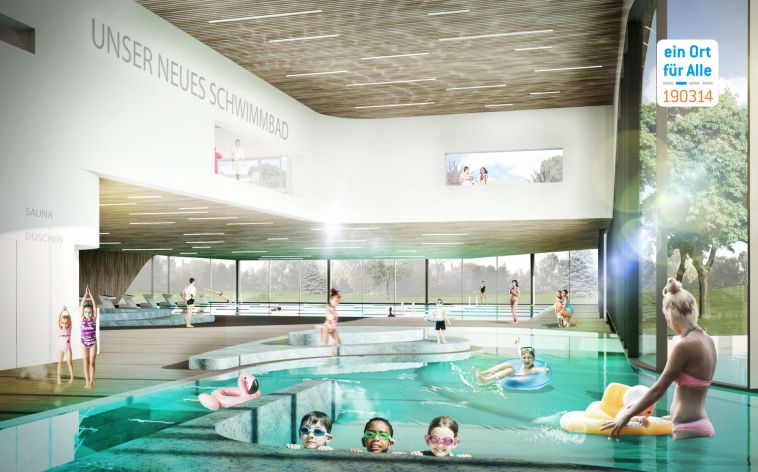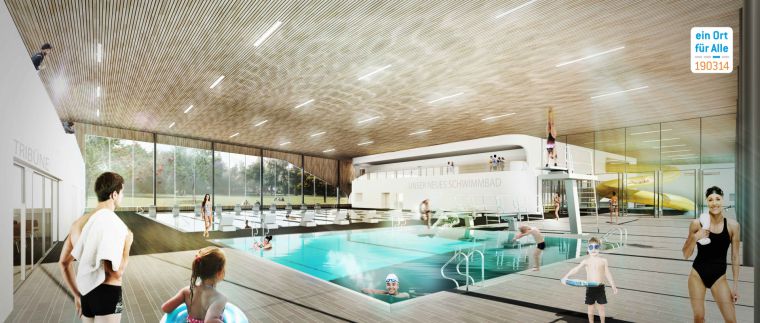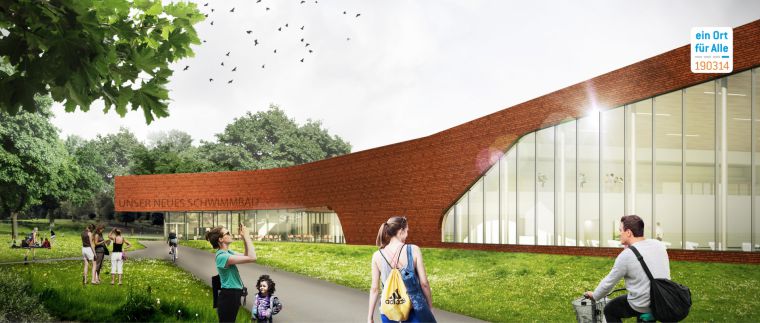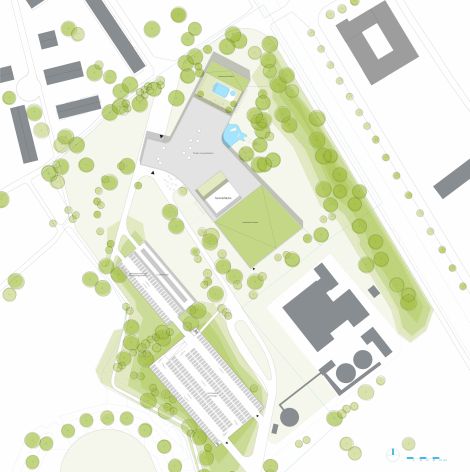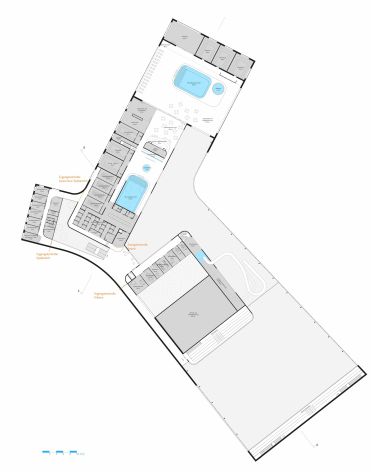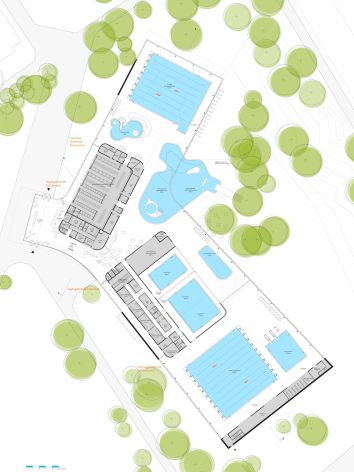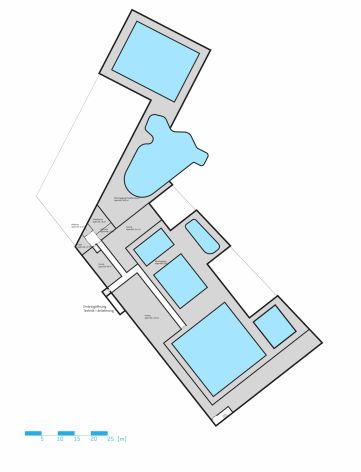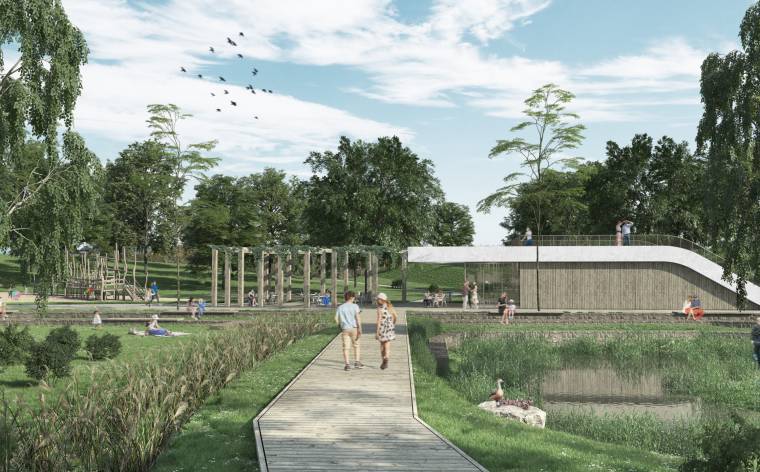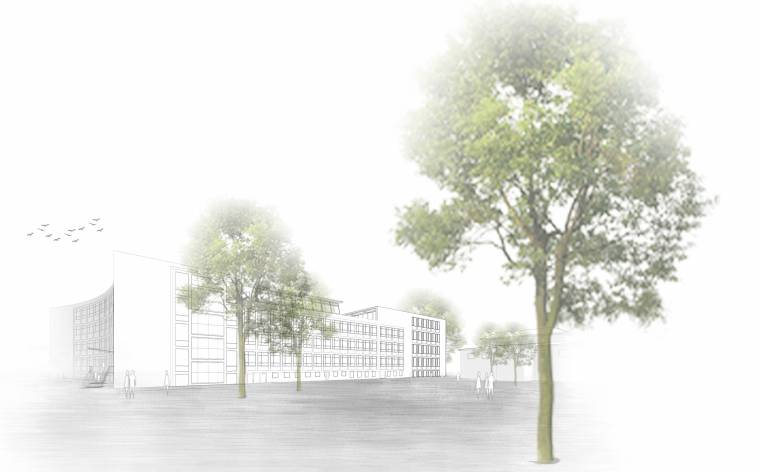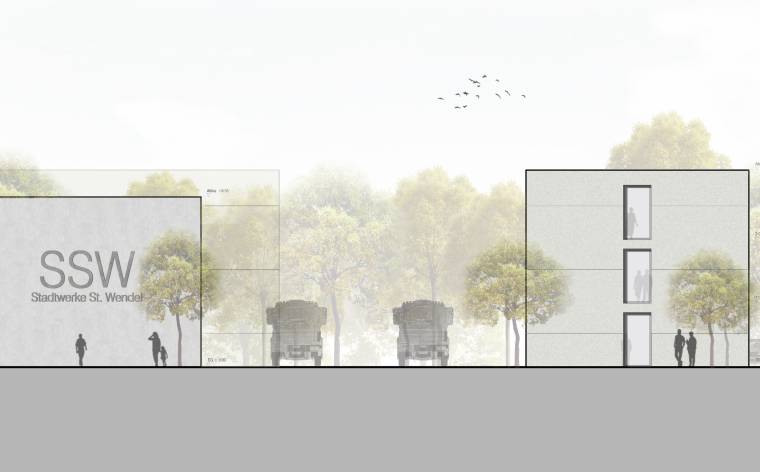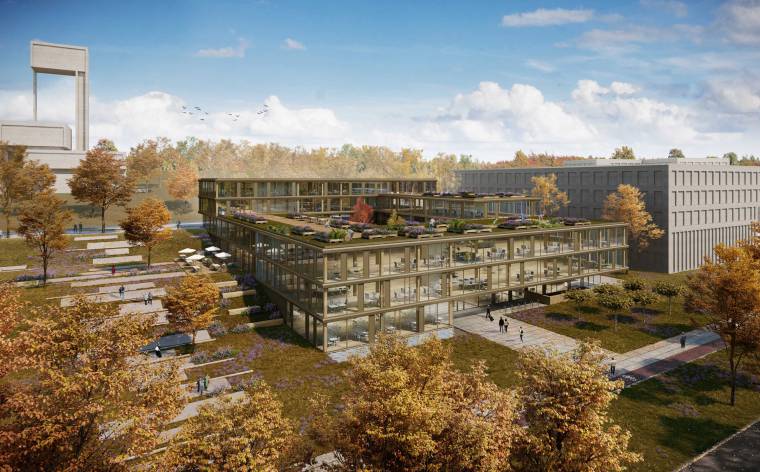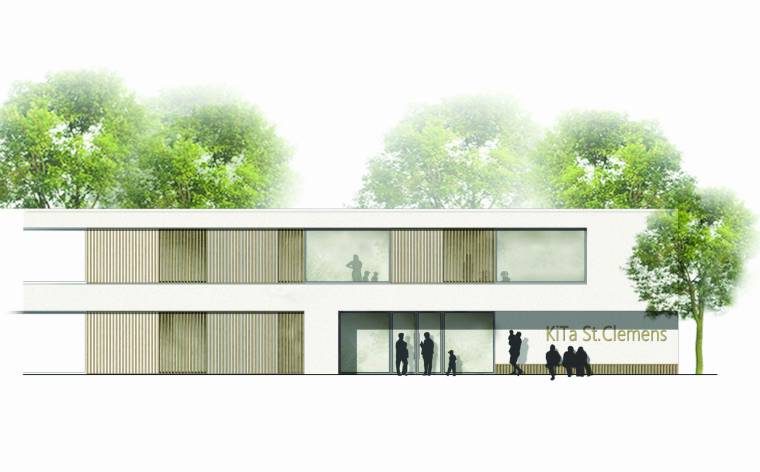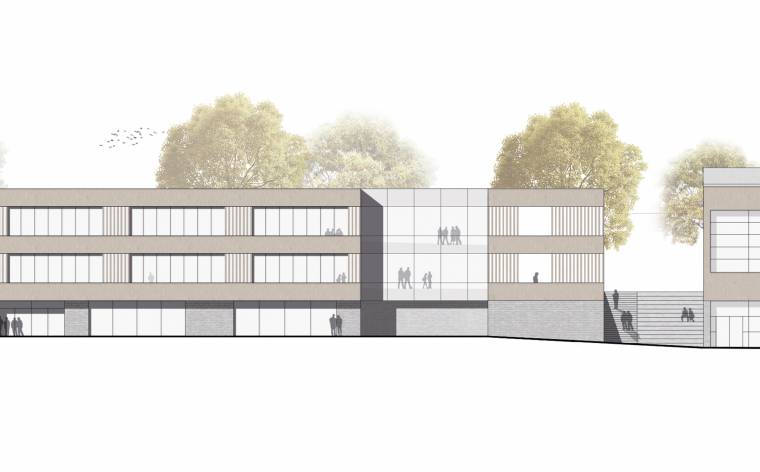Category :
Architecture competitions
Project :
Watterland, family, school and sports swimming pool, Bonn-Dottendorf
Client :
SWB Energie- und Wasserversorgung Bonn/Rhein-Sieg GmbH
Country :
Germany
Area :
gfa 11.300 m²
Planning period :
01/2017 - 04/2017
Uses :
Family, school and sports swimming pool
Share on
project Wasserland: family, school and training pool in Bonn-Dottendorf (GER) contracting authority SWB Energie- und Wasserversorgung Bonn/Rhein-Sieg GmbH, Bonn-Dottendorf (GER) architecture WW+, Esch-sur-Alzette/Trier (LUX/GER), ATELIER PRO, Den Haag (NL) gfa 11.300 m competition phase 01/2017 - 04/2017
Explanatory text for Wasserland project: family, school and training pool in Bonn-Dottendorf:
Our new swimming pool
In its design language, vision and appearance, the new Bonn swimming pool is a reflection of its existing environment. It also optimally implements the agenda of the pool’s various applications.
Urban planning concept
The site of the new Bonn swimming pool borders a green structure, where one of Bonn’s largest sports facilities, the Wasserland stadium, is located. The objective is to preserve these green inner-city open spaces, extending and upgrading them with a new sports facility. Existing trees will be largely saved. The building is embedded into the park and easily accessible from all directions. Thanks to its form and positioning within the site, the new swimming pool nestles into this landscape. The particular footprint and the fluid height pattern of the swimming pool are derived from the internal organisation of the individual functional areas. The interconnected swimming areas are concealed from arriving visitors, exposed to and catching the sun from the south and east. The existing bank, which is planted out and located along the neighbouring tracks, provides noise protection to swimmers. At the same time, the building itself offers noise protection for the surrounding structures. Anticipated noise from the outdoor area of the restaurant is absorbed by a bank to the west; to the north, the curved façade of the entrance area protects the neighbours from noise nuisance.
Access
Visitors arriving by bicycle or on foot via the northern railway crossing catch sight of the swimming pool between the trees. The glass, recessed façade of the family pool provides a first glance inside the building. Visitors are naturally guided to the entrance foyer, respectively the bicycle stands. The bicycle stands are “buried into” a planted-out bank and as a result under cover.
The site can also be accessed exclusively by pedestrians and cyclists from the west, coming from the surrounding residential areas or the public transport stops. A well-developed network of cycling paths ensures direct and quick access of the site from this direction. Visitors cut across the park, an extension of the Wasserland park, and can spot the entrance foyer from a distance. This is where, with its generous projecting roof, the swimming pool welcomes its visitors into a bright foyer.
Conversely, vehicles and school buses can access the building only from the south, via Christian-Miesen-Straße and the building’s site entrance. A two-storey car park, embedded into the bank, is located directly at the site entrance, making it easy for visitors to the surrounding sports facilities to use. This is where the parking is concentrated. Traffic to the swimming pool park is reduced to a minimum in favour of the green spaces and relaxation areas surrounding the pool.
In close proximity to the car park is the bus stop, respectively the turning bay for the school bus. From here visitors can cross through the park to reach the swimming pool. Visitors arriving for international swimming competitions can directly access the training pool from here, since this entrance is combined with an external access to the utility rooms in the cellar. This means that during international competitions, the general public pool can continue to operate undisturbed.
Functional solution
Modulating the space allocation plan into the existing ground layout results not only in the creation of special internal activity areas but also in functional and efficient connections between the individual use areas: the interior spaces merge into the surrounding landscape; there is no longer an obvious separation between inside and outside.
All the main functional areas, such as the school or training pool / leisure pool and sauna, have their own access and are internally connected to the central restaurant.
The centrally positioned reception area has a good view of all the visitors as they arrive. An open lounge area is an inviting place to linger, from which visitors part in different directions.
From here, the changing rooms, the family pool in the north wing and the training pool in the west wing can be accessed. A freestanding staircase connects the foyer with the sauna and spa area, the offices as well as the public gallery above the swimming pool.
The restaurant area with its central kitchen is coupled to the foyer and serves as a connecting element, on the one hand between the indoor and outdoor areas and on the other hand between the various functional areas. Indoors, the restaurant can be reached from the swimming or training area. A glass wall separates the footwear from the barefoot area and provides views onto the swimming pool. The restaurant’s outdoor areas occupy the southeast, where the pool’s protected open spaces are located, and extend to the west for spectators and people waiting outside the building.
The family swimming area featuring an adventure pool and slides, bathing pool and children’s play pool is oriented to the south with a view onto the trees and the park. An adventure pool allows visitors to enjoy open-air swimming.
Between the family area and the training area lies the course area, separated by a glass wall. The fact that course pools have lower height requirements allows the air treatment units to be positioned on the roof and be invisibly absorbed into the structure’s volume.
The course pools can be used separately or collectively and are located immediately next to the changing rooms and the fitness room. Along the slide landing pool visitors reach the training pool, which can be operated separately. The diving pool is near the training pool, since it benefits from the required ceiling height.
Along the closed façade, which faces the HKW thermal power station, are the equipment rooms and multifunctional rooms and above them a gallery, which is also directly accessible from outside. The gallery can seat 250 and is used primarily in competitions. If additional seating is required for competitions, the diving pool is temporarily covered.
The sauna occupies the upper floor of the north wing, where the roof features a generous outdoor area with a sauna landscape. This roof configuration provides this sensitive activity with a quiet and private zone that enjoys the sun from all directions. The swimming area is connected directly to the sauna zone via stairs and a lift.
Architecture and materials
Like a pavilion, the new swimming pool merges into the landscape with its curved form. The main swimming areas are identifiable through the increase of the ceiling height. Visitors are in each case guided to the entrance by the highest points of the building along the curved façade, which is underlined through a projection of the upper floor.
The façade is a game of closed and open surfaces. The transparent façade draws the incoming visitor into the building, catching glimpses of its inside structures, sensing the hustle and bustle.
Despite the transparency, the privacy of users of the more sensitive areas is not compromised.
The closed brick surfaces, for which a warm red was chosen, are a reference to the immediate neighbour, the HKW, and pleasantly fit into the primarily green surroundings. The brick walls, which protect in particular the sauna and spa areas from unwanted views looking in, feature small, irregular openings. In the evening, light shimmers through these openings to the outside, making the façade shine. Along with the desired privacy, visitors inside enjoy views to the outside to the park and surroundings.
Inside, the swimming pool facility features wood panelling on the walls and ceilings, which creates a natural atmosphere and also provides pleasant acoustics. Warm-coloured floor coverings, combined with whitewashed walls, make for a natural and peaceful setting.
To ensure a bird-friendly façade, anechoic solar protection glass is used.
Energy efficiency
The new pool facility adheres to very high sustainability standards. The requirements of the low energy building standard “Kfw-Effizienzhaus 55” are met with the following measures:
- The thermal power station Heizkraftwerk Süd ensures the heating, cooling and power supply of the new swimming pool. The result is a long distance primary energy factor of 0.0.
- Ground plan: to the north and west is a buffer zone for open swimming areas with high temperatures.
- Photovoltaic installation on the roof for power generation.
- Extensive green roof for rainwater retention, insulated and has a positive effect on the indoor climate.
- Compensation of sealed surfaces.
- Ventilation system with highly efficient heat recovery of > 80%.
- Solar energy gains through glass surfaces.
- Use of solar protection glass, against overheating.
- Triple glazing for large-scale glass surfaces.
- Existing tree population protects from overheating in summer.
- Glazed surfaces that can be opened enable an additional regulation of the room temperature in the summer.
- Night-time covering of outdoor water surfaces.
- Preheating of outdoor pools through solar water heating.
- Processing of service water and backwash water for toilets.
- Lighting via energy-saving LED lighting.
- Pool water heat recovery and use of backwash water heat.
- Only a few areas, such as the no-basement rest areas, changing rooms, training rooms, massage areas (ancillary functions), may need to be heated via underfloor heating. In general the heating is achieved via the ventilation system.
- Use of bricks as a robust, easy-maintenance and sustainable façade material.
- Compact building body ensures a good A/V ratio.
- Wasserland Bonn en
- Wasserland Bonn ger
Downloads
Contact us !
